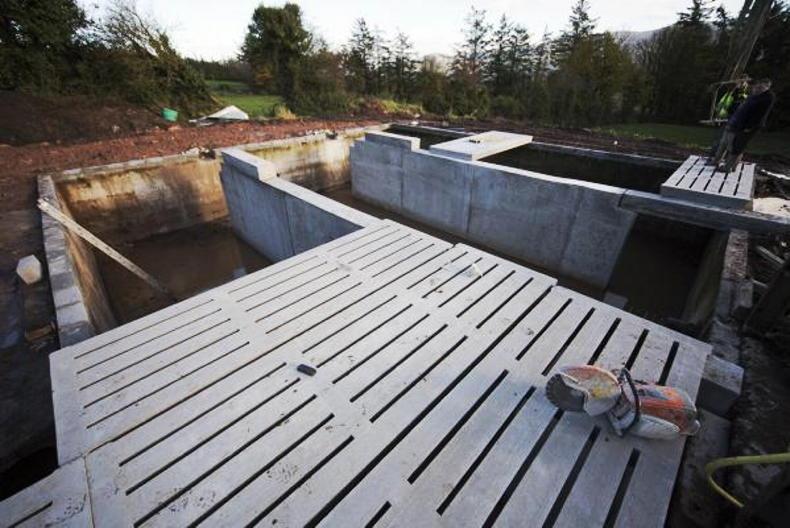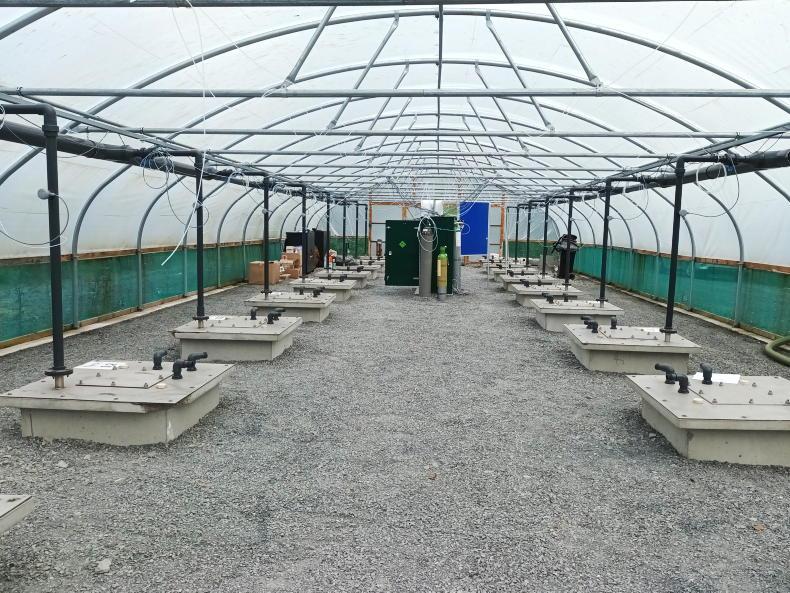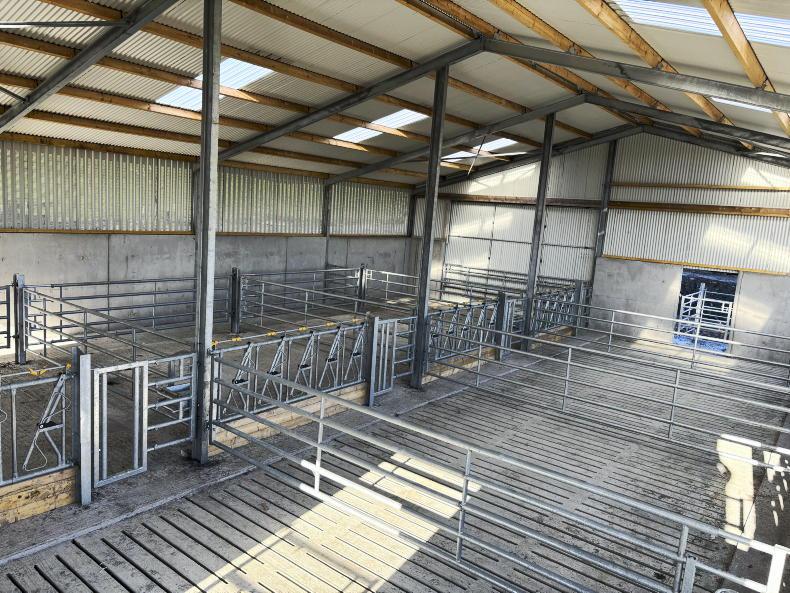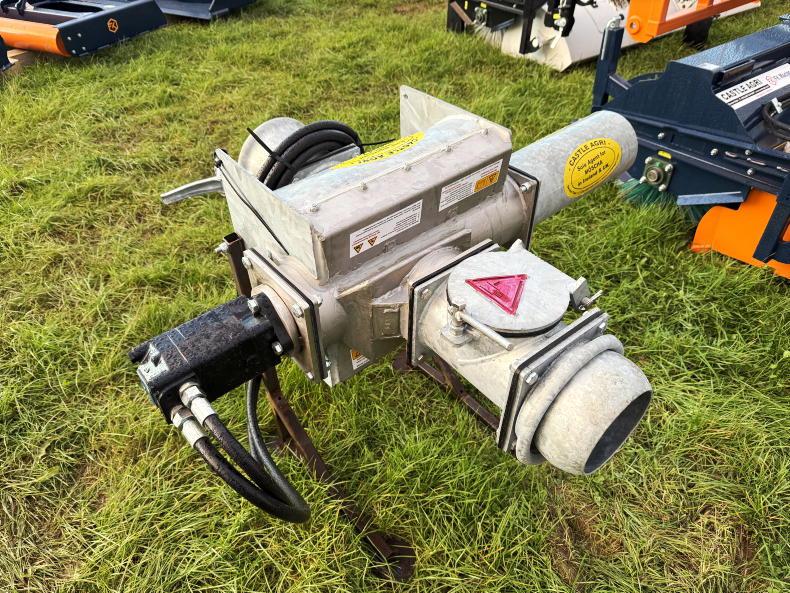Measures introduced in the Department of Agriculture’s Climate Action Plan back in 2020 stated that from 1 January 2022, all newly constructed external slurry stores are required to be covered.
In addition, all existing external slurry stores should be covered as soon as is practically possible, but no later than 31 December 2027.
This measure is in an effort to reduce ammonia losses from the stores, keeping more of the valuable nitrogen in the slurry, with the added benefit of a reduction in chemical nitrogen usage envisaged.
Ireland’s agricultural industry is responsible for 99% of the country’s ammonia emissions.
The rate of ammonia loss is influenced by the air moving over the top of the slurry, so covers will likely be required to prevent air coming into contact with the slurry.
This means two things; it is not a requirement that the cover prevents rainwater entering the slurry storage, but it also means that evaporation of water (which can be as high as 30%) will likely be reduced with any introduction of a cover.
For farmers who are already tight on storage space in an uncovered tank, a cover to prevent rainwater entering is likely the more suitable option.
Concrete slats
Existing uncovered concrete tanks have the benefit of being converted to uncovered or covered slatted areas through the use of reinforced concrete spine walls or pillars.
It is estimated that a slatted outdoor tank sees ammonia losses reduced by 60% as opposed to uncovered tanks.
With the high current cost of raw steel and concrete, this is likely to be one of the more expensive options although it will offer the benefit of additional animal facilities, with the option of roofing the area in the future, if required.
Tom Fallon, Teagasc building specialist, has confirmed that the Department holds no issue with traditional cattle slats being used in an outdoor setting and would be treated as being a covered slurry store.
Some mat manufacturers, such as Easyfix, have created slat mats with a curved surface to remove dung from the floor quickly into the tank.
This is combined with a non-return valve underneath that allows slurry to enter into the tank from above, but prevents the majority of ammonia from leaving.

Existing open concrete tanks may be slatted to create additional wintering accommodation.
There are options available for new and existing slurry towers to be roofed using a PVC cover.
Roofing a slurry tower increases the storage capacity by roughly 20% by preventing water entering the tower, and at the same time prevents a crust forming on the surface which can prove difficult to break up for agitation.
Any roofed cover will be cone-shaped to allow water to flow off to the side, so it is advisable to provide a suitable surface around the tower base to cope with this extra rainwater.
What is still unknown is if venting will be allowed in roofed structures to prevent an excess of gas buildup. An Irish company making slurry tower covers is Cunningham Covers, which offers a bespoke-size PVC cover for slurry towers using reinforced dung resistant PVC polyester coated heavy-duty fabric.
Lagoons will likely be very difficult or impossible to cover effectively with roofing.
An option that will likely be explored by many is a floating cover, which is able to rise and fall, according to the level of slurry in the lagoon.
Although there are options available for fixed covers, these are generally limited to smaller-sized lagoons due to the load placed on them from snow or rainfall.
In the UK, some covers have been able to be fixed by burying into the embankment, with rainfall removed by a small pump. This prevents excess water from entering the lagoon, but causes a headache for sludge removal when necessary.
Where slurry or sawdust is used to bed cubicles, this is likely not to be a good option. Several UK manufacturers are currently manufacturing such covers, which are sometimes required to be fitted in order to achieve planning permission close to urban settings in an effort to limit odour loss.
Where slurry storage capacity is not an issue, and watery slurry is in fact welcome for pumping with an umbilical cord or spreading with LESS equipment, a permeable covering may be more suitable and cost-effective.

LECA is an option for all types of outdoor slurry stores, although it does allow rainfall to still enter.
Lightweight expanded clay aggregate (LECA) or foam glass is applied in a 100mm to 150mm layer which sits on top of the slurry in a concrete tank, slurry tower or lagoon.
The lightness and buoyancy of the material allows it to float, providing an effective barrier between air and slurry.
It is also stated that the iron oxides in the clay mineral structure act as a catalyst for chemisorption of hydrogen sulphide (H2S), ammonia, methane and other organic compounds.
Commercial success
Floating plastic plates, usually hexagonal or circular in shape, have had great success commercially in reducing evaporation from water reservoirs in water-stressed countries and have recently been adopted by the agricultural industry in preventing ammonia losses from open slurry stores.
A layer of plates float on the slurry surface, in a similar way to LECA or foam glass, again create a permeable barrier between air and slurry. It is estimated that the use of floating plastic plates can reduce ammonia losses by as much as 95%.
The permeable options mentioned also hold the benefit of being easy to install and allow for traditional agitation methods.
There are a variety of options available to reduce ammonia losses from slurry stores, but access to some is limited due to a low demand so far in this country.All of the options listed in this article reduce ammonia losses, but no information has been given by the Department on what is authorised, only that traditional cattle slats suffice for a slurry store cover.Clear guidance and information is required immediately from the Department. Otherwise farmers are being left in limbo.Safety issues regarding a cover on slurry stores must also be explored.
Measures introduced in the Department of Agriculture’s Climate Action Plan back in 2020 stated that from 1 January 2022, all newly constructed external slurry stores are required to be covered.
In addition, all existing external slurry stores should be covered as soon as is practically possible, but no later than 31 December 2027.
This measure is in an effort to reduce ammonia losses from the stores, keeping more of the valuable nitrogen in the slurry, with the added benefit of a reduction in chemical nitrogen usage envisaged.
Ireland’s agricultural industry is responsible for 99% of the country’s ammonia emissions.
The rate of ammonia loss is influenced by the air moving over the top of the slurry, so covers will likely be required to prevent air coming into contact with the slurry.
This means two things; it is not a requirement that the cover prevents rainwater entering the slurry storage, but it also means that evaporation of water (which can be as high as 30%) will likely be reduced with any introduction of a cover.
For farmers who are already tight on storage space in an uncovered tank, a cover to prevent rainwater entering is likely the more suitable option.
Concrete slats
Existing uncovered concrete tanks have the benefit of being converted to uncovered or covered slatted areas through the use of reinforced concrete spine walls or pillars.
It is estimated that a slatted outdoor tank sees ammonia losses reduced by 60% as opposed to uncovered tanks.
With the high current cost of raw steel and concrete, this is likely to be one of the more expensive options although it will offer the benefit of additional animal facilities, with the option of roofing the area in the future, if required.
Tom Fallon, Teagasc building specialist, has confirmed that the Department holds no issue with traditional cattle slats being used in an outdoor setting and would be treated as being a covered slurry store.
Some mat manufacturers, such as Easyfix, have created slat mats with a curved surface to remove dung from the floor quickly into the tank.
This is combined with a non-return valve underneath that allows slurry to enter into the tank from above, but prevents the majority of ammonia from leaving.

Existing open concrete tanks may be slatted to create additional wintering accommodation.
There are options available for new and existing slurry towers to be roofed using a PVC cover.
Roofing a slurry tower increases the storage capacity by roughly 20% by preventing water entering the tower, and at the same time prevents a crust forming on the surface which can prove difficult to break up for agitation.
Any roofed cover will be cone-shaped to allow water to flow off to the side, so it is advisable to provide a suitable surface around the tower base to cope with this extra rainwater.
What is still unknown is if venting will be allowed in roofed structures to prevent an excess of gas buildup. An Irish company making slurry tower covers is Cunningham Covers, which offers a bespoke-size PVC cover for slurry towers using reinforced dung resistant PVC polyester coated heavy-duty fabric.
Lagoons will likely be very difficult or impossible to cover effectively with roofing.
An option that will likely be explored by many is a floating cover, which is able to rise and fall, according to the level of slurry in the lagoon.
Although there are options available for fixed covers, these are generally limited to smaller-sized lagoons due to the load placed on them from snow or rainfall.
In the UK, some covers have been able to be fixed by burying into the embankment, with rainfall removed by a small pump. This prevents excess water from entering the lagoon, but causes a headache for sludge removal when necessary.
Where slurry or sawdust is used to bed cubicles, this is likely not to be a good option. Several UK manufacturers are currently manufacturing such covers, which are sometimes required to be fitted in order to achieve planning permission close to urban settings in an effort to limit odour loss.
Where slurry storage capacity is not an issue, and watery slurry is in fact welcome for pumping with an umbilical cord or spreading with LESS equipment, a permeable covering may be more suitable and cost-effective.

LECA is an option for all types of outdoor slurry stores, although it does allow rainfall to still enter.
Lightweight expanded clay aggregate (LECA) or foam glass is applied in a 100mm to 150mm layer which sits on top of the slurry in a concrete tank, slurry tower or lagoon.
The lightness and buoyancy of the material allows it to float, providing an effective barrier between air and slurry.
It is also stated that the iron oxides in the clay mineral structure act as a catalyst for chemisorption of hydrogen sulphide (H2S), ammonia, methane and other organic compounds.
Commercial success
Floating plastic plates, usually hexagonal or circular in shape, have had great success commercially in reducing evaporation from water reservoirs in water-stressed countries and have recently been adopted by the agricultural industry in preventing ammonia losses from open slurry stores.
A layer of plates float on the slurry surface, in a similar way to LECA or foam glass, again create a permeable barrier between air and slurry. It is estimated that the use of floating plastic plates can reduce ammonia losses by as much as 95%.
The permeable options mentioned also hold the benefit of being easy to install and allow for traditional agitation methods.
There are a variety of options available to reduce ammonia losses from slurry stores, but access to some is limited due to a low demand so far in this country.All of the options listed in this article reduce ammonia losses, but no information has been given by the Department on what is authorised, only that traditional cattle slats suffice for a slurry store cover.Clear guidance and information is required immediately from the Department. Otherwise farmers are being left in limbo.Safety issues regarding a cover on slurry stores must also be explored. 











SHARING OPTIONS